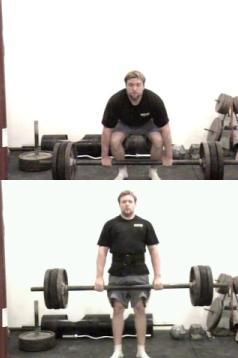
This is a guest post from Shaun Sinclair, founder, and author of Stay Fit Bug. Shaun is a former 100/200-meter runner and professional athlete.
Look after your BACK!
Because once that goes you are FINISHED!
It really is that simple.
The spine and the muscles surrounding it are the backbones to our physical existence ‘Pun intended’.
However, it is a part of our body that is prone to injury. Now, prevention isn’t a difficult thing to do. But one thing I am certain of is that trying to cure the issue of back pain is an entirely different matter (Yes… not always easy).
- Good form
- Good exercise execution
- Embracing good posture
All of those things are highly important when it comes to protecting your back. Heck, embracing good posture isn’t even something you need to worry about in the gym only. In fact, that has a lot more to do with your activities outside of the weight room.
- How you sit at your desk in the office.
- In your bed and how you sleep (sleeping on the floor is still one of the best things you can do).
- How you position your body when using a computer at home, which of course, is where most of us spend most of our time in today’s world on Facebook and the like.
These lifestyle habits are highly important in regard to back injury prevention. Now let’s see how you can change your lifestyle to proactively protect yourself from back injuries.
Some Tips for Maintaining Good Posture
Stand tall/ Walk tall
Keep your head up and your shoulders back and keep your neck aligned with your body. Standing or walking.
Don’t ‘slump over’ when sitting
Slouching causes the back ligaments (not the muscles) to elongate and they will begin to hurt, which will lead to a not-so-good feeling and pressure on your vertebrae.
Sit up straight
Place your back against the back of the chair. Put your feet flat on the floor with your knees a little higher than your hips.
A ‘no brainer’ common-sense solution I know. But I bet you are failing to do this. It’s all about creating habits. Make this one of them!
Sleep on a firm mattress
If you want, you can place a layer of plywood between your box springs and mattress. This is a better alternative than opting to sleep on a flat floor (in my opinion).
Both options will provide a decent amount of back support. However, opting to sleep on a soft mattress could lead to a back sprain or abnormal sagging of the spine.
Can’t handle the challenges of sleeping on a hard mattress?
Then look for mattresses that are posture tested and when shopping for a mattress, ask the salesperson to find a mattress that will provide support and comfort. These types of mattresses will often cost more money. But you get what you pay for. And in this case… good health. So nothing wrong with that. Check out these types of pressure-relieving mattresses from Nolah to get a better idea of what is available.
Extra sleeping tips
Sleep on your side with your knees bent (I just happen to naturally sleep this way 🙂 )
Sleep on your back and place a pillow under your knees (Proves to be effective for overweight or pregnant individuals)
Are you a driver?
If so, place your back against the seat and sit close enough to the wheel so that your knees are bent slightly higher than your hips. Seat cushion rolls can help prevent a sagging back into the base of the car seat.
Why am I focusing on the back muscles?
Because unlike most of your other body parts, It’s painfully hard to recover from a severe back injury. Your back is the frame that holds your entire body up. So in short…
Look after your BACK!
Because once that goes you are FINISHED!
Literally!
I come from a family that has suffered from back injuries. In fact, it’s been quite scary to watch at times. I’m even touching wood as I write this (Really, I am).
I’ve seen grown men reduced to tears because of back injury, and I can tell you now, it’s not a pretty sight. Slipped discs and all.
But if you are reading this article, then I know that you live a fitness lifestyle. A lifestyle where we can in fact improve the way our bodies look, feel, and function. And today I’m going to give you some tips of how you can prevent back injuries and what you can do to strengthen your back muscles in your workouts.
#1 Deadlifting is bad on the back… only if you’re doing it incorrectly

You can actually heal and strengthen your back muscles by performing deadlifts if you have already become a victim of a back injury. My advice would be to start off with a very lightweight. Which of course is the first point I mention in ‘How to lift weights’ in tip #3 below. Doing so will allow you to understand how to lift the weights properly regardless of the exercise.
The Deadlift
Keep your feet flat beneath a stationary parallel bar
Squat down and grab the bar with shoulder width
Lift the bar by extending your hips and knees at full extension.
Pull your shoulders back at top of the lift
Repeat.
Remember
Deadlifts, squats, or any other exercise can be bad for you… ‘only’ if you perform the exercise incorrectly.
#2 Build lower back support by building the right muscle groups
If you want to build up your back support, take a look at your anatomical chart (Erector spinae). You can have erector spinae the size of tree trunks, but you won’t have any lower back support.
Build up your lower back support by engaging your…
Transverse abdominus
Stabilizes the spine and pelvis during lifting movements.
Now we all know about exercises such as leg lifts and crunches. However, those exercises place a stronger focus on your ‘abs’. The exercise below will place a focus on internal abdominal muscles, namely your transverse abdominus muscle, which is of course the goal here.
The exercise…
Vacuum exercise
Not placing a focus on your transverse abdominus and not doing the above will indeed encourage injuries to your spine.
Multifidus
A basic exercise to activate your multifidus.
Stand upright.
Soften your knees and find the neutral lower back position.
Maintain that position, lean forward from the hips 10-15 degrees.
Do not let your back bend.
Hold the position for 10 seconds and then return upright slowly.
Repeat for 10 sets
And one of my favorite multifidus isolation exercises…
The multifidus twist
Pelvic floor muscles
You can activate this area of the body with exercises such as…
- The Pelvic Tilt
This exercise will stretch the muscles and ligaments of the back and will help you maintain a position where your back is a lot more stabilized and less prone to injury. It also strengthens the abdominal muscles that indirectly support the spine.
How to do it
Lie on your back with your arms by side.
Tighten your abdominal muscles while squeezing your glutes (butt muscles)
Bend your knees
Hold for a count of 5
Repeat
Tip
Your hips should not leave the floor.
The only part of your body that should tilt is your pelvis.
Rocking back and fourth.
And two other exercises you can add…
- Passive Extension For Back
This exercise will help you loosen up your back after sitting down for long periods of time. It can also help with acute lower back pain. Again, follow the principles of learning how to perform the exercise properly first.
How to do it
Lie face down with your hands flat on the floor and parallel to your shoulders (The push up position).
Push-up while leaving your hips on the floor.
Lift your head and shoulders as high as possible and let your back sag inwards.
Hold the position for six seconds.
Repeat (10 reps)
- The Oblique Abdominal Exercise
Target areas
Abs
Trunk rotation
How to do it
Lie down with your legs bent, and feet placed firmly on the floor (The same as in the pelvic tilt position).
Raise your left knee while placing your hand on the same knee.
Push your knee with that arm and maintain the pressure for up to ten seconds.
Repeat 10 times
Then switch to legs.
All of the above will indeed help strengthen the said muscle groups and aid in giving you full back support. Over time you will build a strong back support system, at which point you can then consider taking your muscles to the next level (e.g 300lb deadlifts). But you have to build the right muscle groups first.
#3 How to lift
I talked about incorrect form earlier, as a cause of back injury. In fact, poor exercise form is arguably the number one cause for most serious injuries in the gym. For those who aren’t in the know, this is how you should lift (note: Goal for super muscle gains).
How to lift weights
- Start with light weights – This will allow you to understand how to lift the weights properly regardless of the exercise.
- Do the exercise properly – Once you have mastered how to do it, focus on control and execution.
- Lift at moderate speed – Explosive yes! But not fast and not slow. Muscles grow due to explosive activity.
- Increase the weight – Do the above 3, but always aim to increase the weight.
With point no.1 being the most important.
Starting with a light weight will…
a) Help you perform the exercise properly over time.
b) Prepare you for the heavier lifts
#4 Stiff leg dead lifts = Hamstrings tension, not back tension
This is a case where one performs an exercise, but due to incorrect form, they end up performing an entirely different exercise. I’ll use the stiff leg deadlift as an example.
Now, It’s important to note too, that if you feel the tension in your mid/upper back while performing a stiff leg deadlift, then you are doing it wrong. This exercise is geared for the hamstrings. Keep the back at a normal curve and legs straight (slightly bent). If you don’t stick to this, then you are no longer performing a stiff leg deadlift. You’ll probably feel the tension in your back, which could lead to an injury.
And also make you don’t hyperextend on the way up at the top of the lift.
So, the alternative here isn’t so much performing an exercise incorrectly, which often leads to working a different muscle group. No!
The alternative to performing this exercise incorrectly is injury. Avoid it!
#5 Calcium
If your parents were anything like mine, they would have told you to make sure you get enough calcium into your system. Doing so will give you strong bones. And they are right.
The rule of progress:
Progress = 80% diet + 20% exercise
In the fitness and bodybuilding game, the rule is mostly true (Depending on your goals), and suffering from back injuries could be a cause of a calcium deficiency in your body. If so stack up like this:
Nutrition
- Milk and Soy milk
- Orange juice
- Broccoli
- Cheese
- Seaweed
- Almonds
- Figs
- Beans
Supplementation
Make it a habit to take any calcium supplements with the natural foods you consume.
Supplementation consumption is as follows (No more than 600mgs a time)
| Age | Milligrams per day |
|---|---|
| 9-18 years | 1300 |
| (Are you aged 16 years or under? If so lay off the free weights and focus on bodyweight exercises and activities such as martial arts) | |
| 19-50 years | 1000 |
| 51+ years | 1200 |
Following the above will indeed assist you with preventing and curing back pain. But in general, you have to learn how your body works and adapt. It may well be a game of trial and error, but the core rules are still the same. Follow them and you will indeed save your back for years to come.
It is advised that you contact your physician to get a second opinion on whether the advice in this article will benefit you, or not.
Questions for You
Do you suffer from back pain?
Have you used any of the methods above?
What else have you tried to cure back pain?
I’ll see you in the comments below!
Tags: back, deadlifts, Healthy Lifestyle, injuries, injury, injury prevention, legs, prevention











Great point @mike.
Keep in mind that a strong back needs a strong core. Of course the key to a healthy body is overall fitness (that includes the back).
Make sure to keep your ab exercises in mind when going to the gym. Unlike other parts of the body, arms, legs, shoulders, etc. you can work your abs out every other day. This is vital to overall health and injury prevention.
I’ve already bookmarked your post!
Shaun is right! It’s better to prevent a back injury than trying to cure it. Here is an other tip I learned from Eben Pagan. If you spend a lot of time in front of your computer you can actually stand on your feet instead of sitting on a chair all the time. Off course you need a high table to do this. That’s how Eben works, this might work for you as well.
– Michael